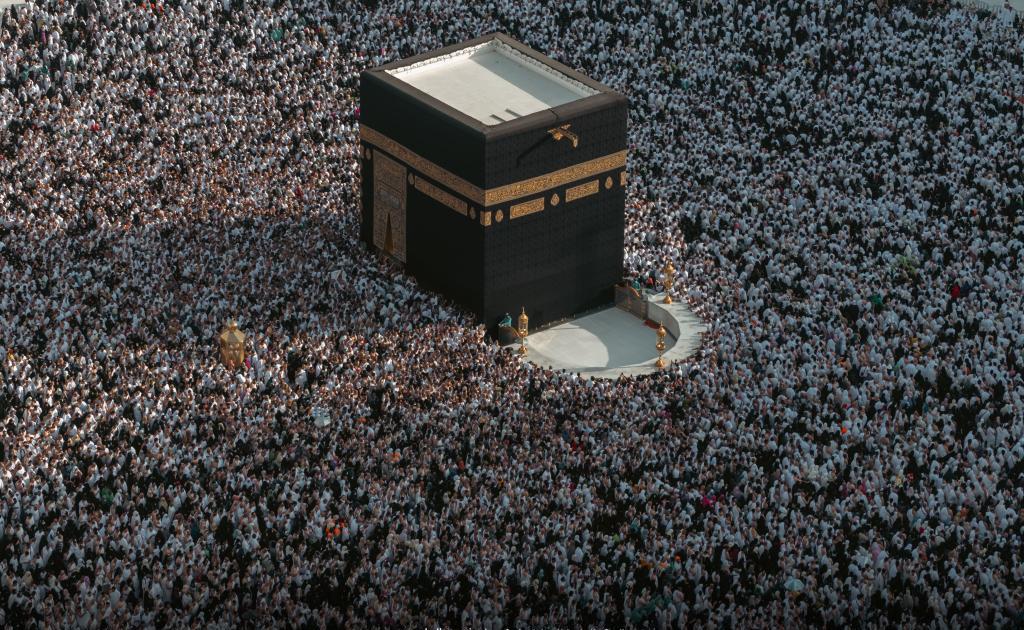The Noble Ka’bah

In the heart of Makkah, where servitude meets The Majestic, the Noble Ka’bah stands tall, bearing witness to the history of Iman and serving as a destination for the Muslims’ hearts. It is the first house (of worship) established for humanity to worship Allah the One and Only, the One who is unique. In support of this it has been stated in the Quran:
“Indeed, the first House [of worship] established for mankind is that at Bakkah, a blessing and a guidance for the creation”
Hagar’s Trust and the Heavenly Response
The valley of Makkah was barren, void of water or vegetation, despite of that Allah commanded His Prophet Ibrahim (may Allah’s salam be upon him), to settle his family there. Obeying his Lord, he left his wife Hagar and their infant son Ismail (may Allah’s salam be upon them both), at that silent valley. Hagar’s trust in Allah was immense, as she said: “Then He, Allah will not abandon us.” Allah then fulfilled her trust, causing the spring of Zamzam to gush forth beneath Ismail’s feet, transforming the lifeless valley into a place full of life.
Building the Ka’bah: Obedience and Supplication.
After that, Allah guided Ibrahim to the location of the Ka’bah and commanded him to build it. Ibrahim and his son Ismail built the House with love and Iman. They would repeatedly supplicate by saying: “Our Lord, accept [this] from us. Indeed, You are the All Hearing, the All Knowing.”
The Ka’bah became a symbol of monotheism and a beacon enlightening Iman in the hearts of humanity.
A History full of Care and Renovation
The history of the Ka’bah includes significant milestones. Over the centuries, nations successively cared for the Ka’bah as time passed and the Ka’bah was to be damaged etc they would rebuild it. Quraysh (the historic Arab tribe) rebuilt the Ka’bah before the revelation to Prophet Muhammad (may Allah’s peace and blessings) but fell short of completing the entire structure due to limited resources.
Subsequently, leaving part of the original foundation, now known as the Hijr, outside its bounds. The Prophet (may Allah’s peace and blessings) wished to rebuild it according to Ibrahim’s original design, including the Hijr be part of the Ka’bah, but he postponed this to maintain harmony among the newly converted community.
Later, Abdullah ibn Al-Zubair rebuilt it according to the Prophet’s (may Allah’s peace and blessings) vision, adding two doors and including the Hijr. However, during Abdul Malik ibn Marwan’s era, it was restored to its previous form. In 1040 AH, after parts of it were damaged by floods, Muslims renovated the Ka’bah, with Sultan Murad Khan; reconstructing it with care and devotion.
In modern times, the Ka’bah has undergone precise restorations to preserve its safety and reverence. In 1417 AH, during the era of King Fahd ibn ‘Abdil- ‘Aziz, both the interior and exterior were restored, ensuring the Ka ‘bah remains a magnificent symbol for the succession of the hands of people of Iman throughout history.
Names Reflecting the Sanctity of the Ka’bah
The Ka’bah is known by several revered names that signify its sacred status: The Sacred House, The Ancient House, and Bakkah. It is a symbol of peace and a direction for worshippers from every corner of the earth.
Spiritual Beauty Inside the Ka’bah
Inside the Ka’bah lies profound mysteries; wooden pillars that support the roof, pure white marble covering the floor. Likewise, the walls are lined with silk curtains adorned with the writing of the beautiful names of Allah. As for the door of the Ka’bah then it is safeguarded by the al-Shaibi family, custodians of the Sacred House (the Ka’bah) for generations, as per the Prophet’s (May Allah’s salah and salam be upon him) instruction:
“Take it, O sons of abu-Talha, as an eternal trust; none shall take it from you except an oppressor.”
Occasions for Opening the Ka’bah
The Ka’bah is opened on two occasions:
Firstly: it’s opened when cleansing it with Zamzam water mixed with oud and rose perfume, conducted twice annually: once at the beginning of Sha’ban and once on the 15th of Dhu al-Qi’dah.
Secondly: To honour visiting heads of states, granting them the privilege of entering, praying within the Ka’bah, because they the Muslims in their respected countries. Therefore, they are permitted to pray in it following the example of the Prophet (may Allah’s salah and salam be upon him) regarding that, they also supplicate and invoke Allah the Almighty and the Magnificent.
Components of the Noble Ka’bah
The Door of the Ka’bah, the Lock and Key of the Ka’bah Door, the Black Stone, the Yemeni Corner, the Hijr, the Mizab (rain gutter), the Multazam, the Kiswa (Ka’bah covering), the Custodians of the Ka’bah and the Shadhrawan (marble base of the Ka’bah).